If verbal assurances were translated into reality, U.S. businesses would be well-ahead of the game when it comes to diversity and inclusion. But that’s just not the case. Unfortunately, a comprehensive study from McKinsey found that far from making progress, gender diversity has stalled.
For a 2018 survey, 279 companies with more than 13 million employees participated in a study on women in the workplace. It found that only one in five C-suite leaders is female and only one in 25 is a woman of color.
Women are overlooked from the outset, thus are less likely to be given managerial roles. In fact, women only hold 38% of managerial positions compared with 62% for men, according to McKinsey. This is despite data showing that more women graduate from college than men, that women seek promotions and negotiate higher wages at the same rate as men, and that they remain in the workforce for the same amount of time as men.
Overcoming centuries of gender inequities will take time, but it is possible to speed up that timeline by re-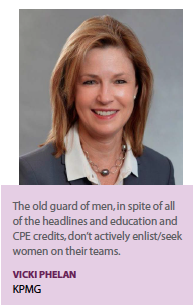 engineering workplaces, says Eloiza Domingo-Snyder, executive director of diversity and inclusion, Astellas.
engineering workplaces, says Eloiza Domingo-Snyder, executive director of diversity and inclusion, Astellas.
“Advancing women into leadership roles will continue to be a challenge if the talent pipeline isn’t filled with women who are management-ready when those opportunities arise," Ms. Domingo-Snyder says. “Men need to be enlisted as allies for gender equality. The challenge is moving the conversation from women versus men, which suggests men stand to lose if women advance. The data show otherwise."
A Catalyst report, Women of Color in the United States, found that women of color have a greater wage gap, with black women working full time earning 61 cents for every dollar earned by white, non-Hispanic men, Latinas earning just 53 cents in the same comparison, and Asian women earning 85 cents in that comparison.
La’Wana Harris, director of global leadership development at Sanofi, says these data highlight the need for organizations to broaden their gender parity initiatives to ensure all women are supported in their efforts. “The first step in closing this gap is to recognize that the experience for women of color is different and requires an intentional approach for meaningful change."
Many of the issues explored by the report can be attributed to unconscious bias, says Julie Ross, president of Advanced Clinical. “If you don’t see or recognize it, how can you change?" she asks.
Patrick Desbiens, senior VP, head US vaccines, GlaxoSmithKline, says unconscious bias can only be recognized through taking time to think about it, and thinking about it needs to evolve into action and behavior change. This means leaders need to walk the walk, efforts need to be made to connect functions that drive diversity initiatives to leaders across the company, and initiatives need to showcase successful diversity programs.
“I am a big supporter of initiatives that support inclusion and diversity at GSK," he says. “One of these is the employee resource groups or ERGs. These groups work to increase awareness of the importance of 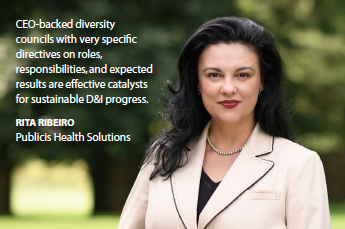 recognizing, supporting, and celebrating what makes us unique and diverse contributors to GSK. In addition, I participate in the reverse-diverse mentoring program, and hold inclusion dialogues with my management team."
recognizing, supporting, and celebrating what makes us unique and diverse contributors to GSK. In addition, I participate in the reverse-diverse mentoring program, and hold inclusion dialogues with my management team."
When the vaccine sales team expanded by 200 people in 2017, GSK proactively planned to hire diverse teams. “The recruitment centers were purposely staffed and led by a diverse group of hiring managers to ensure the candidates could better connect with the organization," Mr. Desbiens says. “We need to be open and overt about the fact that we want everyone to have an equal opportunity to be the best they can be at GSK."
Understanding the Barriers
According to the McKinsey report, women get less support from their managers than men and are less likely to have proper interactions with senior management regarding their work. For black women, these issues are even more pronounced.
Harassment remains a serious problem in the workplace, and yet a large number of workplaces have not committed to stamping out harassment. McKinsey notes that 55% of senior women have faced harassment, 48% of lesbian women have been targeted, and 45% of women in technical fields have been sexually harassed. Yet, only 62% of employees say their company has reiterated that harassment won’t be tolerated.
Ms. Domingo-Snyder says despite some companies making strides to improve gender and ethnic equity in 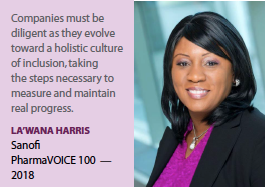 the workplace through equal pay and more balanced policies, the structures that created these original inequities still exist.
the workplace through equal pay and more balanced policies, the structures that created these original inequities still exist.
“Creating accountability structures that advocate for change and actively elevate and position women and people with diverse experiences and perspectives in decision-making roles is critical," she says. “The more reflective we are of the patients we serve, the better we are able to address their unique needs."
Vicki Phelan, managing director, shared services and outsourcing advisory for the life sciences at KPMG, points to several factors that contribute to stalled progress. These include not enough senior women reaching down and helping their fellow women move up, the old guard of men failing to actively enlist women on their teams despite the headlines, education, and CPE credits, and trying to juggle what is often a seven-day week and all the expectations that go along with that vs. motherhood and caregiving.
In the life sciences, where compound development and technology are evolving rapidly, women re-entering the workforce after a few years away to raise children are behind, Julie Ross, president, Advanced Clinical says.
“Companies need to identify active methods to close gaps with those re-entering the workplace while not allowing the time gap to be the reason not to hire, but that is easier said than done," she says.
The McKinsey report also found that one in five women say they are the only woman or one of the only women in the room at work, and among senior-level women in technical roles, about 40% are “onlys."
One key challenge facing women is the additional scrutiny that they often receive when they are the first or the only diverse talent in a position, says Rita Ribeiro, senior director, marketing and communications, Publicis Health Solutions.
“It is imperative that organizations ensure tools and training are in place to foster inclusion and support sustainable sponsorship of ‘only’ employees as part of their D&I progress strategy," she says.
A Helping Hand
Ms. Ribeiro says through her engagement with diverse employees she receives feedback on ways 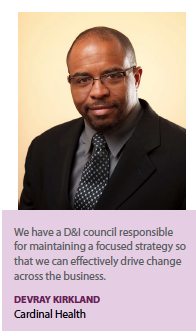 companies can improve diversity efforts. “One simple action that companies can take is to provide additional support for resource groups that are at the front lines of providing a network for diverse employees," she says. “This creates a line of communication to senior leadership allowing issues and concerns to be communicated up through the organization without fear. A second action is to establish an executive level D&I council especially if a company does not have a chief inclusion officer role. CEO-backed diversity councils with very specific directives on roles, responsibilities, and expected results are an effective catalyst for sustainable D&I progress."
companies can improve diversity efforts. “One simple action that companies can take is to provide additional support for resource groups that are at the front lines of providing a network for diverse employees," she says. “This creates a line of communication to senior leadership allowing issues and concerns to be communicated up through the organization without fear. A second action is to establish an executive level D&I council especially if a company does not have a chief inclusion officer role. CEO-backed diversity councils with very specific directives on roles, responsibilities, and expected results are an effective catalyst for sustainable D&I progress."
Ms. Domingo-Snyder says companies striving for improved D&I require a chief diversity officer or a lead for D&I efforts, first and foremost, as well as the allocated budget afforded to other executive-level positions — the chief financial officer, the chief medical office, the chief operations officer, etc.
“Only in this way will D&I be fused into the fabric of an institution, able to achieve true and sustainable, measured success," she says.
For Lisa van Capelle, chief resources officer at Syneos Health, the biggest opportunity lies in seizing chances that come each person’s way and not overthinking readiness. Equally, it’s about consciously supporting one another and lifting up teams to move forward collectively.
“A popular social media post I saw recently perfectly expresses the point that girls compete with each other, women empower one another," Ms. van Capelle says. “Women need to help one another and view our advancement as a team effort. This will strengthen our roots and help us build our confidence ‘muscle,’ which allows us to flex to new opportunities or create our own path when we see a better way forward."
Ms. Harris says companies might address diversity issues by considering questions such as, how can we best empower the unique development needs for women of color and is the talent pipeline and succession plan for key positions inclusive of non-majority women?
“A great place to start is to gain an understanding of the experience of women and non-majority employees in your organization," Ms. Harris says. “Don’t assume that you know what needs to be done to 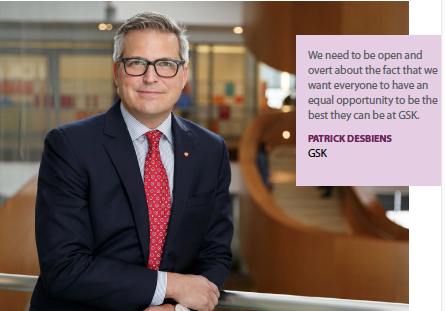 address gender and ethnic/cultural diversity, because the information needed to inform your actions and decisions hinge on the unique perspectives of your employees."
address gender and ethnic/cultural diversity, because the information needed to inform your actions and decisions hinge on the unique perspectives of your employees."
She says the next important step is to work closely with members of these demographics to build a path for success that includes established benchmarks. “Companies need to create a plan not only to increase representation but to retain and develop diverse talent," Ms. Harris adds.
Companies need to establish performance measures based on new norms, which range from language used, to hiring processes, the types of team building events held, and measuring leadership on parity and diversity, Ms. Ross says.
While there’s no cookie-cutter approach for success in D&I, there are some fundamental elements of building successful inclusion and diversity initiatives, Ms. Harris says. These include creating awareness of the business case for diversity, moving to more dedicated phases of inclusion, and ultimately achieving a fully integrated, mature stage organization in which diversity and inclusion are woven into every thread of the fabric of a company’s culture.
According to Devray Kirkland, VP of diversity and inclusion at Cardinal Health, inclusion of everyone is key. For example, Cardinal’s Partners Leading Change Program invites men into the conversation around gender parity, educating them on how their actions are critical to the success of the company’s efforts in this area.
Ms. Ribeiro says while subconscious bias and sensitivity training is a step in the right direction, there also needs to be an accountability process. Other effective strategies can be to partner with industry associations focused on gender parity and equality, such as the Healthcare Businesswomen’s Association, to gain access to gender parity through leaders, best practices, training programs and most importantly, mentoring.
Taking a Lead
According to a separate 2018 McKinsey report, Delivering through Diversity, there is a strong correlation between diversity in the leadership of large companies and financial outperformance. The report found that companies in the top quartile for gender diversity with its executive teams were 21% more likely to surpass others on profitability and 27% more likely to experience superior value creation. When it comes to ethnic diversity, those with people from diverse ethnic or cultural backgrounds were 33% more likely to outperform on profitability. Those at the bottom quartile in terms of diversity were 29% less likely to achieve above-average profitability than all other companies in the data set.
“Providing an environment where employees feel empowered to bring 100% of themselves to work each day results in better performance, stronger development, and longer tenure," Mr. Kirkland says.
The benefits are many-fold, Ms. Phelan adds: better thinking, better perspectives, better solutions, more client-centric focus as the company incorporates different ideas, experiences, cultural backgrounds, sensitivities that are reflective and representative of customers and potential customers.
Diversity commitment gives companies greater relevance to an increasingly global marketplace as well as increased employee engagement and innovation, which leads to increased business results, Ms. Harris points out.
“Businesses would benefit greatly from not only altering employee demographics so they mirror their 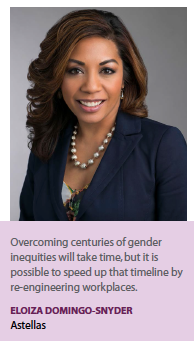 customers’ profiles, but also by building inclusive corporate cultures to support their new makeup, since the days of enforcing a very narrow standard for success are rapidly receding," Ms. Harris says.
customers’ profiles, but also by building inclusive corporate cultures to support their new makeup, since the days of enforcing a very narrow standard for success are rapidly receding," Ms. Harris says.
Indeed, Ms. Phelan has been in a situation where a sales team that was meeting with female executives was exclusively male and predominantly white. Despite advice to change the make-up of the team, no changes were made and, unsurprisingly, their pitch for the business was not won.
“The better a company’s employee base resembles that of its customers, the more competitive it will be," Mr. Desbiens says.
The very essence of diversity provides the opportunity for open-minded collaboration that drives innovation across an organization, Ms. Ribeiro agrees.
And being able to identify solutions and messaging for a broader market segment is particularly important in life sciences where the same products are often being offered across global populations.
When working in an inclusive environment, employee commitment and productivity improves, leading to better retention and lower turnover costs, Ms. Ribeiro points out.
She adds that this approach also organically promotes ambassadors and very often, the formation or growth of employee business resource groups, which have become driving forces in a company’s recruitment, retention, industry visibility, and corporate social responsibility efforts.
“At the end of the day, seeking diverse viewpoints creates richer experiences that benefits us all — employees, customers, and patients," Ms. van Capelle says.
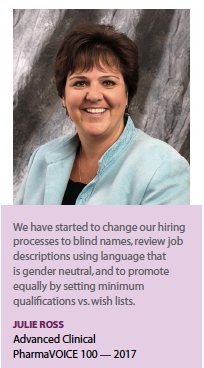 Aside from the evidence-based benefits, such as greater employee engagement, higher rates of retention, improved reputational value, and growth in innovative contributions, strong diversity and inclusion programs also serve as a way to manage and mitigate against risk within the current national and global environments, Astellas’ Ms. Domingo-Snyder says.
Aside from the evidence-based benefits, such as greater employee engagement, higher rates of retention, improved reputational value, and growth in innovative contributions, strong diversity and inclusion programs also serve as a way to manage and mitigate against risk within the current national and global environments, Astellas’ Ms. Domingo-Snyder says.
“We are in a unique place in our world and nation right now, and much of the conversations concern dynamic diversity-based topics," she says. “A dedicated D&I leader and program enables companies to proactively address issues, ensuring they are actively engaged with relevant national discussions."
Ms. Domingo-Synder says one of the reasons she was attracted to Astellas Americas was the company’s record of accomplishments and demonstration of walking the talk.
“Real change versus rhetoric will move the needle," she says.(PV)
~~~~~~~~~~~~~~~~~~~~~~~~~
Driving Successful D&I Initiatives at a Corporate Level
State the goal from top of the house
Leaders model the right behaviors
Deploy programs across the organization
Provide education about unconscious biases
Stress the importance of having diverse teams/thinking
Keep a modern workplace mindset
Take actions in line with supporting the commitment to I&D
Source: Patrick Desbiens, Senior VP, Head US Vaccines, GSK
~~~~~~~~~~~~~~~~~~~~~~~~~
HBA’s Gender Parity Collaborative Takes a Bold Stand for Action and Accountability
The Healthcare Businesswomen’s Association’s Gender Parity Collaborative is the first consortium of healthcare and life-sciences companies committed to addressing the systemic and environmental changes needed to accelerate gender parity to enable even better business results. Women can and should continue to lean in. In parallel, organizations must identify and eliminate conditions and practices that hamper progress and prevent full realization of their female talent pipeline. This is the mission of the HBA’s Collaborative.
Twelve founding member organizations — all prominent leaders in healthcare — have stepped forward to partner with HBA to review diversity data, set priorities, and build accountability for action and improvements. Going beyond a promise or pledge, the Collaborative is committed to action and measuring results. HBA organized and launched this consortium and will be acting as the core convener and facilitator across member companies. HBA has established a strategic relationship with McKinsey & Company for the data capture and analytics necessary for success.
At the group’s first council meeting in November 2018, executives from the 12 founding member companies worked together to set priorities. During two solution summits planned for 2019, they will reconvene to tackle these priorities, leveraging the expertise and experience across the industry.
HBA invites all healthcare and life-sciences industry companies to join the Collaborative to partake in the implementation of effective corrective action to accelerate the business benefits of gender diversity. For more information, please contact HBA at [email protected].
The HBA Gender Parity Collaborative’s Founding Member Organizations:
Advanced Clinical
Bristol-Myers Squibb
Celgene
Eli Lilly and Company
GlaxoSmithKline
Medidata Solutions
Novartis
Pfizer
Quest Diagnostics
Genentech- Roche
Sanofi
~~~~~~~~~~~~~~~~~~~~~~~~~
D&I Best Practices
Diversity leaders share some of the initiatives being carried out by their organizations — either at work or in community groups — to advance diversity objectives.
 Eloiza Domingo-Snyder
Eloiza Domingo-Snyder
Executive Director, Diversity and Inclusion, Astellas
At Johns Hopkins Medicine, I was honored to be involved with the creation of the Center for Transgender Health, which not only addressed historical nuances of transgender medicine, but created new pathways for culturally competent care for transgender patients, their families, and friends. This plan involved intricately connected variables, including education for care providers, curriculum review for the School of Medicine, re-engineering of the EMR system to ensure accurate patient information, review of insurance access, and establishment of provider networks for safe patient journeys.
At Astellas, the ground-breaking female-empowerment conference that the company held for its employees in 2016 is another example of how an organization can address diversity and inclusion. Female employees, their daughters, and peer company pharma women were invited, along with male executives to a two-day event that included transcendent female speakers and workshops to build skills and develop competencies. I believe that the greatest and most successful D&I programs involve these variables of not just strong tactics, but sustainable, well-thought-out strategies.
 La’Wana Harris
La’Wana Harris
Director of Global Leadership Development, Sanofi
To increase the effectiveness of year-end reviews, we are building a framework for inclusive performance management. Working with the global inclusion and diversity team, we integrated and deployed “Inclusion Nudges" in our performance and talent management cycle. We provided tools for all leaders to develop a strategy to recognize and mitigate bias throughout the performance cycle. There was also a series of video scenarios to help with pragmatic application on the job. These tools are designed to help leaders with self-reflection before beginning the performance management process and practice principles that make review discussions more effective. The collaboration between the global teams for leadership development, talent management, and I&D helped to provide a well-rounded approach that is taking us another step toward embedding inclusive leadership behaviors throughout the organization.
 Vicki Phelan
Vicki Phelan
Managing Director, Shared Services and Outsourcing Advisory for the Life Sciences, KPMG
I started an event with Barbara Melby of Morgan Lewis called Women in Shared Services and Outsourcing, which is now in its 14th year. Our tagline for WISSO is: “the only event where sharing is rampant." The purpose has been to focus on the absence of senior-level women in the outsourcing space.
We targeted women who were leaders in the outsourcing space — cross-functional, cross industry, director level and above — and enjoined 20 women the first year. We sold out in our New York event in May 2018, our San Francisco November 2018 event, and will start a London event in 2019.
 Rita Ribeiro
Rita Ribeiro
Senior Director, Marketing & Communications, Publicis Health Solutions
I serve as the local chapter lead for a global female leadership development group. With executive sponsorship, funding, and guidance on program development to make our mission and message visible the new chapter quickly surpassed all membership and engagement expectations. Further, it generated enough recognition and employee empowerment to drive the launch of local chapters for three other business resource groups and increase company representation at industry-level events. The inclusive and supportive environment of diversity business resource groups creates opportunities for managers to identify new leadership potential within the organization. Across multiple companies I found that employee groups typically also serve on external boards, mentor through industry and community organizations, and bring back to work the leadership skills they acquire through these activities. This strengthens our organization’s internal pipeline for career succession and drives employee retention.
 Lisa van Capelle
Lisa van Capelle
Chief Human Resources Officer, Syneos Health
As a company made up of more than 60% females, Syneos Health set out to launch a recognition program to honor and further develop our female leaders. Modeled after the prestigious women’s leadership awards given by the Healthcare Businesswomen’s Association (HBA) — the Rising Stars and Luminary awards — the Syneos Health award program that launched in 2017 includes criteria related to our own company values. The program was purpose-built to serve as a nominating pool for those to be honored at the annual HBA Woman of the Year event and provide the internal rewards of expanded career visibility opportunities and peer-to-peer connectivity. In just two years, we’ve honored 43 women worldwide from the U.S., Australia, Serbia, France, and England.
We also have a Women’s Leadership Group, which has organically grown out of our consulting business. We’re looking to expand this across Syneos Health to provide a forum to address the unique issues women face in the workplace and promote a greater sense of connection for our female leaders at all levels. This group supports an inclusive work culture by creating tools, resources, and relationships so that our female talent can address key professional development and leadership issues relevant to women.
As a new organization, we continue to evolve how we engage and use pulse surveys to target populations and provide two-way insights.


















